财务会计概念框架
财务会计概念框架

前言目前,财务会计概念框架已经成为财务会计理论的核心内容。
许多西方发达国家(如美国、英国、加拿大、澳大利亚等)和国际会计准则委员会都非常重视对财务会计概念框架的研究,并已纷纷建立起各自的概念框架体系。
随着 2006 年 2 月 15 日新《企业会计准则——基本准则》的发布,我国现阶段既符合国际惯例又具有中国特色的财务会计概念框架已经初步建立。
但是,新的基本准则仍存在一些不足之处,需要在诸多方面继续努力完善,才能早日转化为更符合国际惯例的财务会计概念框架。
2005 年 6 月 2 日财政部向外发布了征求意见稿,即修订后的《企业会计准则—基本准则》。
2006 年 2 月,财政部发布了《企业会计准则—基本准则》和 38 项具体准则,实现了我国会计准则与国际财务报告准则的实质性趋同。
财政部规定从 2007 年 1 月 1 日起,上市公司开始实施新的企业会计准则,并争取所有大中型企业在短时间内执行新准则,即从 2007 年开始,中国企业将采用与国际逐步接轨的会计准则体系进行其经营活动。
由于我国现阶段财务会计概念框建立时间不长,国内学者对于作为我国现阶段财务会计概念框架的新基本准则的研究还不够全面和深入本文通过纵向差异分析和横向国际对比,全方位介绍了我国现阶段财务会计概念框架的内容,对其特色和不足之处作了深刻地评价,本文为我国基本准则的进一步修订给出的 3 点具体意见以及对我国财务会计概念框架的未来发展提出的4 点宏观性建议则具有重大的理论和现实意义。
1财务会计概念框架概述1.1 财务会计概念框架的定义1976 年,美国 FASB 在《概念框架研究计划的范围与影响》中将“财务会计概念框架(conceptual framework of financial accounting,简称 CF)”作为一个专门术语提出来。
FASB 认为,概念框架是由互相关联的目标和基本概念所组成的逻辑一致的体系,这些目标和基本概念可以用来引导首尾一贯的准则,并对财务会计的性质、作用和局限性做出规定。
如何理解财务会计概念框架研究的意义和作用
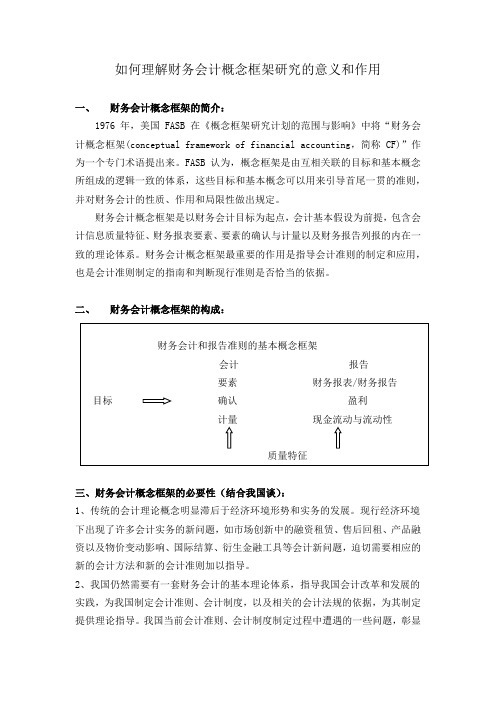
如何理解财务会计概念框架研究的意义和作用一、财务会计概念框架的简介:1976 年,美国 FASB 在《概念框架研究计划的范围与影响》中将“财务会计概念框架(conceptual framework of financial accounting,简称 CF)”作为一个专门术语提出来。
FASB 认为,概念框架是由互相关联的目标和基本概念所组成的逻辑一致的体系,这些目标和基本概念可以用来引导首尾一贯的准则,并对财务会计的性质、作用和局限性做出规定。
财务会计概念框架是以财务会计目标为起点,会计基本假设为前提,包含会计信息质量特征、财务报表要素、要素的确认与计量以及财务报告列报的内在一致的理论体系。
财务会计概念框架最重要的作用是指导会计准则的制定和应用,也是会计准则制定的指南和判断现行准则是否恰当的依据。
二、财务会计概念框架的构成:三、财务会计概念框架的必要性(结合我国谈):1、传统的会计理论概念明显滞后于经济环境形势和实务的发展。
现行经济环境下出现了许多会计实务的新问题,如市场创新中的融资租赁、售后回租、产品融资以及物价变动影响、国际结算、衍生金融工具等会计新问题,迫切需要相应的新的会计方法和新的会计准则加以指导。
2、我国仍然需要有一套财务会计的基本理论体系,指导我国会计改革和发展的实践,为我国制定会计准则、会计制度,以及相关的会计法规的依据,为其制定提供理论指导。
我国当前会计准则、会计制度制定过程中遭遇的一些问题,彰显了制定发布我国财务会计概念框架的必要性。
如一些会计准则、会计制度相互之间出现不太协调的情况;前后不同时间发布的会计准则中规定的具体内容不能体现一以贯之的会计理念;某些经济业务的会计处理方法存在着实用主义的做法、为一时所需的机会主义的做法。
更有甚者,特别是在财政部以外的其他部门所起草的法规中,存在着一些与会计理论的要求不符合的规定和做法。
这些规定和做法,或是出于某些特定目的的需要,或是出于某些特定部门的利益的需要,明显偏离会计理论、会计基本概念的要求。
关于我国财务会计概念框架的构建

综观我 国的会计发展状况 ,在 充分估 计会计改革所取得巨大成就 的同时 , 也毋 庸讳言存在的问题。在我 国的会计实践中 ,对财 务报表 的要 求散见于 《 中华人民共和国会 计法 》、国务院颁布的 《 企业财 务 会计报 告条例 》 、 《 企业会计准则 》、 《 企业会计制度 》等相关 的规
§由 肛跫 一L年第l 、 一 2 o o
知 识 经 济
关 于我 国财 务会 计 概 念 框 架 的构 建
黄 玮 玮
( 南工业技 师学院 ) 河
摘 要 从世界 经济的发展 趋势来看 ,构建财务会计概念框 架已经成为 国际会计发展 的大方向:在现 有环境 约束下 ,我 国构建财
务 会计概 念框 架是一种 必然性 ,但会计环境 的差异决定 了我 国在制定财务会计概念框 架过程 中,在吸收外 国会计理论的 同时而 必须结 合我国特殊的会计环境制定相 应的财务会计概念框 架。 关 键 词 财 务 会 计 概 念 框 架 会 计 环 境 1 财务会计概念框架的形成
机构 强有 力的支持 。从这个 角度看 ,中国已经具备 了隐性 的必 要条 件 。例如 ,我国的会计准则委员会是在财政 部的领导 下开展工作的 , 国务院直接发布 《 企业财务报告条例 》 显示 了最高行政机关对会计问 题 的重视 ,证 监会也在 加强对 资本市场 中上 市公 司和券商 的会 计监 管 ,这些都促成了对财务会计概念框架的现 实需求和 支持 。我们建议
定的准则常包括一些界限检验 ,致使例外情况在检验点两 侧的相关交 易的会计处理不同 ,导致 了准则 内在的不一致性 。这为试图操纵财务 报告 ,进行盈余管理 的人提 供了机会 。而且经济环境 日 益复杂 ,使准
司, 这说 明资本市场正 以较快 的速度发展。在这一令人欣喜又不无忧 虑 的重大发展背景之下 ,规范资本市场和上市公司的会计行 为已成 为 当务之急 。 ( )中国 已经初步 具备了政府和准则制定机构 支持建立会计概 3
美国财务会计概念框架—NO.6

Statement of Financial AccountingConcepts No. 6CON6 Status PageElements of Financial Statements a replacement of FASB Concepts Statement No. 3 (incorporating an amendment of FASB ConceptsStatement No. 2)December 1985Financial Accounting Standards Boardof the Financial Accounting Foundation401 MERRITT 7, P.O. BOX 5116, NORWALK, CONNECTICUT 06856-5116Copyright © 1985 by Financial Accounting Standards Board. All rights reserved. No part of this publication may be reproduced, stored in a retrieval system, or transmitted, in any form or by any means, electronic, mechanical, photocopying, recording, or otherwise, without the prior written permission of the Financial Accounting Standards Board.Statement of Financial Accounting Concepts No. 6Elements of Financial StatementsDecember 1985CONTENTSParagraphNumbers Highlights Introduction.................................................................................................................1–23 Scope and Content of Statement.............................................................................1–8 Other Possible Elements of Financial Statements............................................3–4Elements and Financial Representations..........................................................5–7Other Scope and Content Matters (8)Objectives, Qualitative Characteristics, and Elements.........................................9–19Interrelation of Elements—Articulation.............................................................20–21Definition, Recognition, Measurement, and Display.........................................22–23 Definitions of Elements .........................................................................................24–133Assets..................................................................................................................25–34Assets...............................................................................26–31CharacteristicsofTransactions and Events That Change Assets..............................................32–33Accounts (34)ValuationLiabilities............................................................................................................35–43Characteristics of Liabilities.........................................................................36–40 Transactions and Events That Change Liabilities.........................................41–42Accounts (43)ValuationEffects of Uncertainty.........................................................................................44–48Equity or Net Assets ..........................................................................................49–59 Equity of Business Enterprises andNet Assets of Not-for-Profit Organizations..................................................50–53 Equity and Liabilities................................................................................................54–59 Equity of Business Enterprises...........................................................................60–65Characteristics of Equity of Business Enterprises..............................................60–63Transactions and Events That Change Equity of Business Enterprises..............64–65 Investments by and Distributions to Owners............................................................66–69 Characteristics of Investments by and Distributions to Owners.........................68–69Comprehensive Income of Business Enterprises................................................70–77Concepts of Capital Maintenance.......................................................................71–72 Characteristics, Sources, and Components of Comprehensive Income........73–77 ............................................................................................................78–79Revenues (79)RevenuesofCharacteristicsNumbers Expenses.............................................................................................................80–81Expenses (81)CharacteristicsofGains and Losses ...............................................................................................82–89 Characteristics of Gains and Losses.............................................................84–86Revenues, Expenses, Gains, and Losses.......................................................87–89 Net Assets of Not-for-Profit Organizations .....................................................90–106 Characteristics of Net Assets of Not-for-Profit Organizations....................90–91Classes of Net Assets..................................................................................92–102Restrictions...................................................................95–97Donor-ImposedRestrictions................................................98–100PermanentandTemporaryRestrictions Affect Net Assets Rather Than Particular Assets...........101–102 Maintenance of Net Assets.......................................................................103–106 Transactions and Events That ChangeNet Assets of Not-for-Profit Organizations..............................................107–116Revenues, Expenses, Gains, and Losses...................................................111–113Reclassifications.......................................................................................114–116 Changes in Classes of Net Assets of Not-for-Profit Organizations................117–133 Change in Permanently Restricted Net Assets.........................................119–122 Characteristics of Change in Permanently Restricted Net Assets......120–122 Change in Temporarily Restricted Net Assets..........................................123–126 Characteristics of Change in Temporarily Restricted Net Assets.......124–126 Change in Unrestricted Net Assets...........................................................127–133 Characteristics of Change in Unrestricted Net Assets........................128–133 Accrual Accounting and Related Concepts..........................................................134–152 Transactions, Events, and Circumstances.......................................................135–138 Accounting........................................................................................139–140AccrualAccrual and Deferral (Including Allocation and Amortization).....................141–142Realization and Recognition (143)Recognition, Matching, and Allocation..........................................................144–152 Appendix A: Background Information.................................................................153–163 Appendix B: Characteristics of Assets, Liabilities, and Equity orNet Assets and of Changes in Them...............................................................164–255Purpose and Summary of Appendix...............................................................164–170Characteristics of Assets.................................................................................171–191Future Economic Benefits...............................................................................172–182Costs.......................................................................................178–182AssetsandControl by a Particular Entity...................................................................183–189Control and Legal Rights..........................................................................186–187Benefits.............................................................................188–189NoncontrolledOccurrence of a Past Transaction or Event.....................................................190–191Characteristicsof Liabilities...........................................................................192–211 Required Future Sacrifice of Assets.........................................................193–198NumbersandProceeds (198)LiabilitiesParticular Entity...............................................................199–205aofObligationOccurrence of a Past Transaction or Event...............................................206–211 Characteristics of Equity of Business Enterprises..........................................212–214Interest (213)ResidualInvested and Earned Equity (214)Characteristics of Comprehensive Income ofBusiness Enterprises and Its Components................................................215–220 Interest in Information about Sources of Comprehensive Income.....219–220 Characteristics of Net Assets and Changes in the Classes of Net Assets of....................................................................221–228Not-for-ProfitOrganizationsInterest (222)ResidualInterest in Information about Changes in Classes of Net Assets..............223–228 Examples to Illustrate Concepts.....................................................................229–255 Deferred Gross Profit on Installment Sales..............................................232–234Debt Discount, Premium, and Issue Cost.................................................235–239Deferred Income Tax Credits....................................................................240–242Deferred Investment Tax Credits..............................................................243–245Deferred Costs of Assets...........................................................................246–250Estimated Loss on Purchase Commitments..............................................251–253Minority Interests and Stock Purchase Warrants (254)Examples Do Not Govern Practice (255)Summary Index of Concepts Defined or Discussed............................................page 75Amendment of FASB Concepts Statement No. 2,Qualitative Characteristics of Accounting Information..................................page 78CON 6: Elements of Financial Statementsa replacement of FASB Concepts Statement No. 3(incorporating an amendment of FASB Concepts Statement No. 2)CON 6 HIGHLIGHTS[Best understood in context of full Statement]•Elements of financial statements are the building blocks with which financial statements are constructed—the classes of items that financial statements comprise. The items in financial statements represent in words and numbers certain entity resources, claims to those resources, and the effects of transactions and other events and circumstances that result in changes in those resources and claims.•This Statement replaces FASB Concepts Statement No. 3, Elements of Financial Statements of Business Enterprises, expanding its scope to encompass not-for-profit organizations as well.•This Statement defines 10 interrelated elements that are directly related to measuring performance and status of an entity. (Other possible elements of financial statements are not addressed.)— Assets are probable future economic benefits obtained or controlled by a particular entity as a result of past transactions or events.— Liabilities are probable future sacrifices of economic benefits arising from present obligations of a particular entity to transfer assets or provide services to other entities in the future as a result of past transactions or events.— Equity or net assets is the residual interest in the assets of an entity that remains after deducting its liabilities. In a business enterprise, the equity is the ownership interest. In a not-for-profit organization, which has no ownership interest in the same sense as a Copyright © 1985, Financial Accounting Standards Board N ot for redistributionbusiness enterprise, net assets is divided into three classes based on the presence or absence of donor-imposed restrictions—permanently restricted, temporarily restricted, and unrestricted net assets.— Investments by owners are increases in equity of a particular business enterprise resulting from transfers to it from other entities of something valuable to obtain or increase ownership interests (or equity) in it. Assets are most commonly received as investments by owners, but that which is received may also include services or satisfaction or conversion of liabilities of the enterprise.— Distributions to owners are decreases in equity of a particular business enterprise resulting from transferring assets, rendering services, or incurring liabilities by the enterprise to owners. Distributions to owners decrease ownership interest (or equity) in an enterprise.— Comprehensive income is the change in equity of a business enterprise during a period from transactions and other events and circumstances from nonowner sources. It includes all changes in equity during a period except those resulting from investments by owners and distributions to owners.— Revenues are inflows or other enhancements of assets of an entity or settlements of its liabilities (or a combination of both) from delivering or producing goods, rendering services, or other activities that constitute the entity's ongoing major or central operations.— Expenses are outflows or other using up of assets or incurrences of liabilities (or a combination of both) from delivering or producing goods, rendering services, or carrying out other activities that constitute the entity's ongoing major or central operations.— Gains are increases in equity (net assets) from peripheral or incidental transactions of an entity and from all other transactions and other events and circumstances affecting the entity except those that result from revenues or investments by owners.— Losses are decreases in equity (net assets) from peripheral or incidental transactions of an entity and from all other transactions and other events and circumstances affecting the entity except those that result from expenses or distributions to owners.•The Statement defines three classes of net assets of not-for-profit organizations and the changes in those classes during a period. Each class is composed of the revenues, expenses, gains, and losses that affect that class and of reclassifications from or to other classes.— C hange in permanently restricted net assets during a period is the total of (a) contributions and other inflows during the period of assets whose use by the organization is limited by donor-imposed stipulations that neither expire by passage of time nor can be fulfilled or otherwise removed by actions of the organization, (b) other asset enhancements and diminishments during the period that are subject to the same kinds of Copyright © 1985, Financial Accounting Standards Board N ot for redistributionstipulations, and (c) reclassifications from (or to) other classes of net assets during the period as a consequence of donor-imposed stipulations.— C hange in temporarily restricted net assets during a period is the total of (a) contributions and other inflows during the period of assets whose use by the organization is limited by donor-imposed stipulations that either expire by passage of time or can be fulfilled and removed by actions of the organization pursuant to those stipulations, (b) other asset enhancements and diminishments during the period subject to the same kinds of stipulations, and (c) reclassifications to (or from) other classes of net assets during the period as a consequence of donor-imposed stipulations, their expiration by passage of time, or their fulfillment and removal by actions of the organization pursuant to those stipulations.— C hange in unrestricted net assets during a period is the total change in net assets during the period less change in permanently restricted net assets and change in temporarily restricted net assets for the period. It is the change during the period in the part of net assets of a not-for-profit organization that is not limited by donor-imposed stipulations.Changes in unrestricted net assets include (a) revenues and gains that change unrestricted net assets, (b) expenses and losses that change unrestricted net assets, and (c) reclassifications from (or to) other classes of net assets as a consequence of donor-imposed stipulations, their expiration by passage of time, or their fulfillment and removal by actions of the organization pursuant to those stipulations.•The Statement also defines or describes certain other concepts that underlie or are otherwise closely related to the 10 elements and 3 classes defined in the Statement.•Earnings is not defined in this Statement. FASB Concepts Statement 5 has now described earnings for a period as excluding certain cumulative accounting adjustments and other nonowner changes in equity that are included in comprehensive income for a period.•The Board expects most assets and liabilities in present practice to continue to qualify as assets or liabilities under the definitions in this Statement. The Board emphasizes that the definitions neither require nor presage upheavals in present practice, although they may in due time lead to some evolutionary changes in practice or at least in the ways certain items are viewed. They should be especially helpful in understanding the content of financial statements and in analyzing and resolving new financial accounting issues as they arise. •The appendixes are not part of the definitions but are intended for readers who may find them useful. They describe the background of the Statement and elaborate on the descriptions of the essential characteristics of the elements and classes, including some discussions and illustrations of how to apply the definitions.Copyright © 1985, Financial Accounting Standards Board N ot for redistribution•This Statement amends FASB Concepts Statement No. 2, Qualitative Characteristics of Accounting Information, to apply it to financial reporting by not-for-profit organizations. Statements of Financial Accounting ConceptsThis Statement of Financial Accounting Concepts is one of a series of publications in the Board's conceptual framework for financial accounting and reporting. Statements in the series are intended to set forth objectives and fundamentals that will be the basis for development of financial accounting and reporting standards. The objectives identify the goals and purposes of financial reporting. The fundamentals are the underlying concepts of financial accounting—concepts that guide the selection of transactions, events, and circumstances to be accounted for; their recognition and measurement; and the means of summarizing and communicating them to interested parties. Concepts of that type are fundamental in the sense that other concepts flow from them and repeated reference to them will be necessary in establishing, interpreting, and applying accounting and reporting standards.The conceptual framework is a coherent system of interrelated objectives and fundamentals that is expected to lead to consistent standards and that prescribes the nature, function, and limits of financial accounting and reporting. It is expected to serve the public interest by providing structure and direction to financial accounting and reporting to facilitate the provision of evenhanded financial and related information that helps promote the efficient allocation of scarce resources in the economy and society, including assisting capital and other markets to function efficiently.Establishment of objectives and identification of fundamental concepts will not directly solve financial accounting and reporting problems. Rather, objectives give direction, and concepts are tools for solving problems.The Board itself is likely to be the most direct beneficiary of the guidance provided by the Statements in this series. They will guide the Board in developing accounting and reporting standards by providing the Board with a common foundation and basic reasoning on which to consider merits of alternatives.However, knowledge of the objectives and concepts the Board will use in developing standards also should enable those who are affected by or interested in financial accounting standards to understand better the purposes, content, and characteristics of information provided by financial accounting and reporting. That knowledge is expected to enhance the usefulness of, and confidence in, financial accounting and reporting. The concepts also may provide some guidance in analyzing new or emerging problems of financial accounting and reporting in the absence of applicable authoritative pronouncements.Statements of Financial Accounting Concepts do not establish standards prescribing accounting procedures or disclosure practices for particular items or events, which are issued by the Board as Statements of Financial Accounting Standards. Rather, Statements in this series describe concepts and relations that will underlie future financial accounting standards and practices and in due course serve as a basis for evaluating existing standards and practices.* The Board recognizes that in certain respects current generally accepted accounting Copyright © 1985, Financial Accounting Standards Board N ot for redistributionprinciples may be inconsistent with those that may derive from the objectives and concepts set forth in Statements in this series. However, a Statement of Financial Accounting Concepts does not (a) require a change in existing generally accepted accounting principles; (b) amend, modify, or interpret Statements of Financial Accounting Standards, Interpretations of the FASB, Opinions of the Accounting Principles Board, or Bulletins of the Committee on Accounting Procedure that are in effect; or (c) justify either changing existing generally accepted accounting and reporting practices or interpreting the pronouncements listed in item (b) based on personal interpretations of the objectives and concepts in the Statements of Financial Accounting Concepts.Since a Statement of Financial Accounting Concepts does not establish generally accepted accounting principles or standards for the disclosure of financial information outside of financial statements in published financial reports, it is not intended to invoke application of Rule 203 or 204 of the Rules of Conduct of the Code of Professional Ethics of the American Institute of Certified Public Accountants (of successor rules or arrangements of similar scope and intent).†Like other pronouncements of the Board, a Statement of Financial Accounting Concepts may be amended, superseded, or withdrawn by appropriate action under the Board's Rules of ProcedureINTRODUCTIONScope and Content of Statement1. This Statement defines 10 elements of financial statements: 7 elements of financial statements of both business enterprises and not-for-profit organizations—assets, liabilities, equity (business enterprises) or net assets (not-for-profit organizations), revenues, expenses, gains, and losses—and 3 elements of financial statements of business enterprises only—investments by owners, distributions to owners, and comprehensive income.1 It also defines three classes of net assets of not-for-profit organizations and the changes in those classes during a period—change in permanently restricted net assets, change in temporarily restricted net assets, and change in unrestricted net assets. The Statement also defines or describes certain other concepts that underlie or are otherwise related to those elements and classes (See Summary Index).2. This Statement replaces FASB Concepts Statement No. 3, Elements of Financial Statements of Business Enterprises, extending that Statement's definitions to not-for-profit organizations.2 It confirms conclusions in paragraph 2 of Concepts Statement 3 that (a) assets and liabilities are common to all organizations and can be defined the same for business and not-for-profit organizations, (b) the definitions of equity (net assets), revenues, expenses, gains, and losses fit both business and not-for-profit organizations, and (c) not-for-profit organizations have no need for elements such as investments by owners, distributions to owners, and Copyright © 1985, Financial Accounting Standards Board N ot for redistributioncomprehensive income. Thus, this Statement continues unchanged the elements defined in Concepts Statement 3, although it contains added explanations stemming from characteristics of not-for-profit organizations and their operations. It also defines three classes of net assets of not-for-profit organizations, distinguished by the presence or absence of donor-imposed restrictions, and the changes in those classes during a period—change in permanently restricted, temporarily restricted, and unrestricted net assets.Other Possible Elements of Financial Statements3. Although the elements defined in this Statement include basic elements and are probably those most commonly identified as elements of financial statements, they are not the only elements of financial statements. The elements defined in this Statement are a related group with a particular focus—on assets, liabilities, equity, and other elements directly related to measuring performance and status of an entity. Information about an entity's performance and status provided by accrual accounting is the primary focus of financial reporting (FASB Concepts Statement No. 1, Objectives of Financial Reporting by Business Enterprises, paragraphs 40-48, and FASB Concepts Statement No. 4, Objectives of Financial Reporting by Nonbusiness Organizations, paragraphs 38-53). Other statements or focuses may require other elements.34. Variations of possible statements showing the effects on assets and liabilities of transactions or other events and circumstances during a period are almost limitless, and all of them have classes of items that may be called elements of financial statements. For example, a statement showing funds flows or cash flows during a period may include categories for funds or cash provided by (a) operations, (b) borrowing, (c) issuing equity securities, (d) sale of assets, and so forth. Other projects may define additional elements of financial statements as needed. Elements and Financial Representations5. Elements of financial statements are the building blocks with which financial statements are constructed—the classes of items that financial statements comprise. Elements refers to broad classes, such as assets, liabilities, revenues, and expenses. Particular economic things and events, such as cash on hand or selling merchandise, that may meet the definitions of elements are not elements as the term is used in this Statement. Rather, they are called items or other descriptive names. This Statement focuses on the broad classes and their characteristics instead of defining particular assets, liabilities, or other items. Although notes to financial statements are described in some authoritative pronouncements as an integral part of financial statements, they are not elements. They serve different functions, including amplifying or complementing information about items in financial statements.46. The items that are formally incorporated in financial statements are financial representations (depictions in words and numbers) of certain resources of an entity, claims to those resources, and the effects of transactions and other events and circumstances that result in changes in those resources and claims. That is, symbols (words and numbers) in financial statements stand for cash in a bank, buildings, wages due, sales, use of labor, earthquake damage Copyright © 1985, Financial Accounting Standards Board N ot for redistributionto property, and a host of other economic things and events pertaining to an entity existing and operating in what is sometimes called the "real world."7. This Statement follows the common practice of calling by the same names both the financial representations in financial statements and the resources, claims, transactions, events, or circumstances that they represent. For example, inventory or asset may refer either to merchandise on the floor of a retail enterprise or to the words and numbers that represent that merchandise in the entity's financial statements; and sale or revenue may refer either to the transaction by which some of that merchandise is transferred to a customer or to the words and numbers that represent the transaction in the entity's financial statements.5Other Scope and Content Matters8. Appendix A of this Statement contains background information. Appendix B contains explanations and examples pertaining to the characteristics of elements of financial statements of business enterprises and not-for-profit organizations.Objectives, Qualitative Characteristics, and Elements9. The focus of the FASB concepts Statements that underlie this one is usefulness of financial reporting information in making economic decisions—reasoned choices among alternative uses of scarce resources. Concepts Statement No. 1, Objectives of Financial Reporting by Business Enterprises, emphasizes usefulness to present and potential investors, creditors, and others in making rational investment, credit, and similar decisions. Concepts Statement No. 4, Objectives of Financial Reporting by Nonbusiness Organizations, emphasizes usefulness to present and potential resource providers and others in making rational decisions about allocating resources to not-for-profit organizations.6 Concepts Statement No. 2, Qualitative Characteristics of Accounting Information, emphasizes that usefulness of financial reporting information for those decisions rests on the cornerstones of relevance and reliability. 10. The definitions in this Statement are of economic things and events that are relevant to investment, credit, and other resource-allocation decisions and thus are relevant to financial reporting.7 Those decisions involve committing (or continuing to commit) resources to an entity. The elements defined are an entity's resources, the claims to or interests in those resources, and the changes therein from transactions and other events and circumstances involved in its use of resources to produce and distribute goods or services and, if it is a business enterprise, to earn a profit. Relevance of information about items that meet those definitions stems from the significance of an entity's resources and changes in resources (including those affecting profitability).11. Economic resources or assets and changes in them are central to the existence and operations of an individual entity. Both business enterprises and not-for-profit organizations are in essence resource or assets processors, and a resource's capacity to be exchanged for cash or Copyright © 1985, Financial Accounting Standards Board N ot for redistribution。
财务会计概念框架的基本内容

财务会计概念框架的基本内容财务会计概念框架是把财务会计知识系统化的方法,按照主题划分出每一部分的内容,对财务会计的概念、原则和规则进行描述并进行分类整理,以便帮助财务人员更加清楚地理解财务会计工作。
财务会计概念框架在不同国家间有所差异,但基本内容是一致的,包括以下几个方面:首先,会计原则(Accounting Principles)。
会计原则是会计记账的基本准则,是对财务报表中财务活动进行记录、报告和表述的核心准则,包括实质性原则、相对实质性原则、实质性观念原则和会计记账的总体规则等。
其次是会计估计(Accounting Estimates),它是根据会计原则进行的估计,常用来补充会计原则所无法提供的信息,它主要包括有确定性估计和不确定性估计。
此外,财务会计概念框架还有会计准则和报告准则(Accounting Standards and Reporting Standards),会计准则是指会计部门在制定各项会计操作记账、报表等标准,以便全面考核财务活动;报告准则指企业应按照财务报告标准,及时准确地发布内部财务事项及外部财务活动情况。
此外,财务会计概念框架还包括会计信息系统(Accounting Information System),会计信息系统是会计部门组织、设计的、关联的和互相协调的会计信息体系,它可以帮助企业管理和控制财务活动,为企业决策和管理提供及时有效的信息支持。
此外,从内部控制角度出发,财务会计概念框架还包括内部审计(Internal Audit),内部审计是企业为实现内部控制目标,采取的一套有效的管理制度,通过采取有效的审计策略,有效遏制财务活动中的不规范行为和风险。
最后,财务会计概念框架还包括决策会计(Managerial Accounting),它的主要内容是为企业管理者提供与可行的经济决策有关的信息,其目的在于帮助管理者作出更具有战略性、更符合投资者利益最大化的经济决策,以实现企业价值最大化,尽可能地使企业受益。
我国财务会计概念框架的构建

要素 确认
基础
运行 报告
报告 盈利
报告现金流 量与流动性
报告财 务状况
图1 财务会计概念框架项目的结构
4、如何构建我国的财务会计概念框架
使用者 财务会计目标
质量特征 会计要素
会计假设
会计要素的确认与计量
报告
图2 财务会计概念框架组成及逻辑关系
4、如何构建我国的财务会计概念框架
4.4 完善实施保障制度 加强宣传和解释, 使人们逐渐认识到 基本准则仅是现阶段的一个过渡, 最 后将按照与国际财务会计概念框架 趋同的要求来构建我国的财务会计 概念框架。
1.财务会计概念框架概述
1.2 财务会计概念框架的作用
指导会计准则制定机构发展新的会计准则
评估已有会计准则的质量 在缺乏公认会计原则的领域,指导会计实务
有助于会计信息使用者更好地理解财务报告
1.财务会计概念框架概述
1.3 我国目前的财务会计概念框架现状
目前我国没有系统的财务会计概念框架, 只有会计基本准则。尽管基本准则中含有某 些概念框架的内容,如关于会计假设、会计目 标等表述,但是不管在内容上还是形式上基本 准则都与概念框架有很大区别,具体表现在:
2、构建我国财务会计概念框架的必要 性 2.4 现有的财务会计准则不能代替财务会计概念框架
(1)基本会计准则理论深度不够。因为它是以法
律的形式规定,所以比较抽象,有些条款比较难理 解。
(2)基本会计准则灵活性差。从适用的范围来看, 基本准则适用于我国境内所有企业,但是在实务应 用中却表现出种种问题。
3、西方经验借鉴
美国是首先建立CF的国家, 1978年开始, 美国财务会计准则委员会(FASB)先后发布 了7份财务概念公告。此后,国际会计准则委员 会(IASC)、英国、澳大利亚、加拿大等国家 也开始效仿美国的做法,制定了相应的公告或 准则行使概念框架的作用。
财务会计概念框架ppt课件

在会计假设方面除了保留了原先已有的假设, 还新增了权责发生制,可以更好的检查资源 受托者的受托责任的履行情况。从权责发生制的增加和现金流量表的重视这方面来讲, 我国的会计准则越发靠近FASB的财务会计概念框架,因为权责发生制和对现金流量表的 重视,源于会计目标的改变,不再是为满足国家宏观经济管理的需要等。
of Financial Statement)
财务会计概念框架
国内外的机构、学者对财务会计概念框架的定义有许多种,在此不一一赘述,见仁见智, 莫衷一是,但我们可以透过种种定义发现这样几点:
① CF是财务会计体系中一个最最基本的东西,是“宪章”。不是会计准则,是用来 评价、制定和发展会计准则的会计理论。
② CF是一个理论体系 ③ CF的主要作用是为具体会计规范服务的(如会计准则、会计制度),为新的具体
会计规范的制定,已有的具体会计规范的完善提供指导;特殊情况下还为具体会计规 范的缺失起到拾遗补缺的作用。
④ CF依其形成的逻辑思路可分为两类,即规范性的CF和描述性的CF。
FASB是典型的规范性的财务概念框架,其形成的思路是演绎法,这也是当今学术界广为 推广的。
澳大利亚的财务会计概念公告SAC (Statements Of Financial Accounting Concepts)
加拿大特许会计师CICA财务报表概念FSC (Financial Statements Concepts)
国际会计准则委员会IASC(后改为国际会计准则理事会IASB,下文皆以IASB显示)的编 报财务报表的框架( Framework for The Preparation and Presentation
2018财务会计概念框架 -回复

2018财务会计概念框架-回复什么是2018财务会计概念框架。
2018财务会计概念框架(以下简称“框架”)是国际会计准则委员会(International Accounting Standards Board,IASB)制定的一项指导性文件,用来规范企业财务报告的准则和要求。
框架为财务会计提供了一个综合性的概念框架,在制定和解释会计准则时提供了指导。
框架共包括8个章节,分别是:第一章:目标和总体原则第二章:财务报告的特征和核心概念第三章:资产、负债和所有者权益的定义和辨认标准第四章:财务报表元素的评估标准第五章:财务报告的计量第六章:财务报表的报告日期和持续性假设第七章:资本维持和流动性分配第八章:财务报告的概要、修订和扩展接下来,本文将一步一步回答与框架相关的问题。
第一步:框架的目标是什么?框架的目标是提供一个一致、可理解和可比较的财务报告基础,以供用户做出经济决策。
框架旨在引导制定财务会计准则,确保财务报表真实、公正地反映企业的财务状况、经营成果和现金流量。
第二步:框架中的核心概念是什么?框架中的核心概念有财务报表的可靠性、公正性、财务报告的真实和公正性原则、会计信息的有用性、财务报表的连续性假设、实体的成本概念、货币计量概念和资本维持概念。
第三步:框架中定义了什么是资产、负债和所有者权益?框架定义了资产为过去交易或事件产生的对企业未来有望产生经济利益的资源;负债为过去交易或事件产生的企业未来需履行的经济利益;所有者权益为企业对所有者的经济利益的绝对剩余权益。
第四步:框架如何评估财务报表元素?框架中对财务报表元素进行了评估,包括资产和负债的确认、收入和费用的确认以及净资产的计算。
第五步:财务报表的计量方法有哪些?框架中提供了四种计量方法,分别是历史成本、公允价值、现值和现金流量。
第六步:框架如何处理财务报表的报告日期和持续性假设?框架规定财务报表应以同一日期为基础编制,持续性假设要求企业在合理期限内继续经营。
国际会计准则理事会《财务报告概念框架》

国际会计准则理事会《财务报告概念框架》《财务报告概念框架》(Conceptual Framework for Financial Reporting)是由国际会计准则理事会(International Accounting Standards Board,IASB)发布的指导性文件,用于制定和修订国际财务报告准则(International Financial Reporting Standards,IFRS)。
本文将介绍《财务报告概念框架》的背景、目的、重要组成和实施意义等方面内容。
一、背景二、目的《财务报告概念框架》旨在为制定和修订IFRS提供指导,并确立了财务报告的核心目标、用户和财务报告的要素等。
其具体目标如下:1.提供一个概念性的框架,以帮助理解和应用IFRS;2.确定财务报告的质量要求,包括可靠性、相关性、可比性和可理解性等;3.区分信息主体,包括投资者、债权人和其他利益相关者;4.确定财务报告的要素,包括资产、负债、所有者权益、收入和费用等;5.提供指导,以解决在制定和修订IFRS时出现的具体问题。
三、重要组成《财务报告概念框架》由三个主要部分组成,分别是核心原则、会计报告的要素和会计报告的质量要求。
1.核心原则:包括企业实体原则、连续经营原则、会计期间原则和货币计量原则。
这些原则确保了财务报告的统一性和准确性。
2.会计报告的要素:包括资产、负债、所有者权益、收入和费用等。
这些要素构成了财务报告的基本结构和分类。
3.会计报告的质量要求:包括可靠性、相关性、可比性和可理解性等。
这些要求确保了财务报告的真实性、及时性和可理解性。
四、实施意义《财务报告概念框架》对于全球财务报告准则的制定和修订起到了重要的指导作用,具有以下实施意义:1.统一全球会计准则:《财务报告概念框架》为全球制定和修订会计准则提供了一个统一的框架,使各国的会计准则更加一致和可比较。
2.提高财务报告的质量:《财务报告概念框架》规定了财务报告的核心目标和质量要求,可以帮助企业提高财务报告的质量和可靠性。
会计概念框架
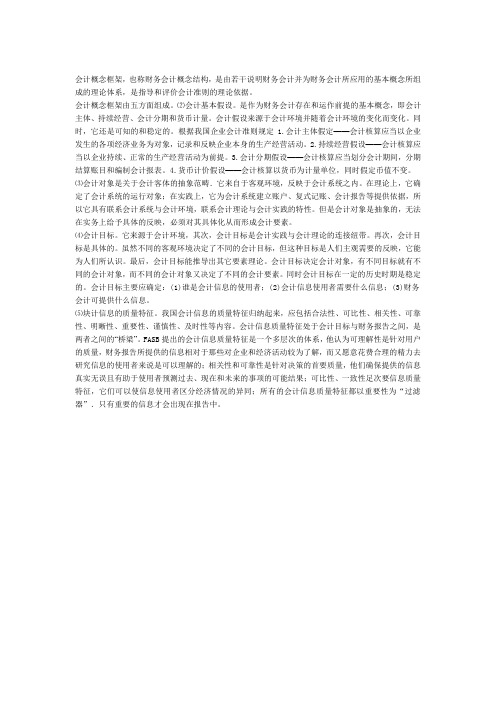
会计概念框架,也称财务会计概念结构,是由若干说明财务会计并为财务会计所应用的基本概念所组成的理论体系,是指导和评价会计准则的理论依据。
会计概念框架由五方面组成。
⑵会计基本假设。
是作为财务会计存在和运作前提的基本概念,即会计主体、持续经营、会计分期和货币计量。
会计假设来源于会计环境并随着会计环境的变化而变化。
同时,它还是可知的和稳定的。
根据我国企业会计准则规定 1.会计主体假定——会计核算应当以企业发生的各项经济业务为对象,记录和反映企业本身的生产经营活动。
2.持续经营假设——会计核算应当以企业持续、正常的生产经营活动为前提。
3.会计分期假设——会计核算应当划分会计期间,分期结算账目和编制会计报表。
4.货币计价假设——会计核算以货币为计量单位,同时假定币值不变。
⑶会计对象是关于会计客体的抽象范畴.它来自于客观环境,反映于会计系统之内。
在理论上,它确定了会计系统的运行对象;在实践上,它为会计系统建立账户、复式记账、会计报告等提供依据,所以它具有联系会计系统与会计环境,联系会计理论与会计实践的特性。
但是会计对象是抽象的,无法在实务上给予具体的反映,必须对其具体化从而形成会计要素。
⑷会计目标。
它来源于会计环境,其次,会计目标是会计实践与会计理论的连接纽带。
再次,会计目标是具体的。
虽然不同的客观环境决定了不同的会计目标,但这种目标是人们主观需要的反映,它能为人们所认识。
最后,会计目标能推导出其它要素理论。
会计目标决定会计对象,有不同目标就有不同的会计对象,而不同的会计对象又决定了不同的会计要素。
同时会计目标在一定的历史时期是稳定的。
会计目标主要应确定:(1)谁是会计信息的使用者;(2)会计信息使用者需要什么信息;(3)财务会计可提供什么信息。
⑸块计信息的质量特征。
我国会计信息的质量特征归纳起来,应包括合法性、可比性、相关性、可靠性、明晰性、重要性、谨慎性、及时性等内容。
会计信息质量特征处于会计目标与财务报告之间,是两者之间的“桥梁”。
中美财务会计概念框架的比较
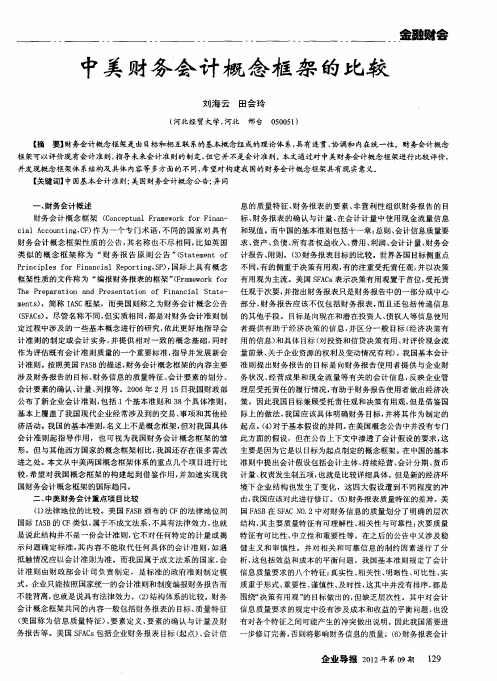
框架性质 的文件 称为 “ 编报财务报表 的框架 ”F a e o k f r 有用观为主流 美 国 S A s表示决策有用观置于首位 , 托责 (r m w r o FC 受
T P pa he re rat on nd i a Pre nt ti n o Fi nci l S ate se a O f na a t —
形 。但 与 其 他 西 方 国 家 的 概 念 框 架 相 比 , 国 还存 在 很 多 需 改 主要是因为它是 以 目标为起 点制定 的概念框架。在 中国的基本 我
进之处 。 本文从 中美两 国概念框架体系的重点几个项 目进行 比 准则中提出会计假设包括会 计主体、 持续经营、 会计 分期、 币 货 较, 希望对我 国概念 框架 的构 建起到借 鉴作用 , 并加速 实现我 计量 、 权责发生制五项 , 也就是 比较详细具体。但是新的经济环 国财务会计 概念 框架的国际趋 同。 二、 中美财务会计重点项 目比较 境下企业 结构也发生 了变 化 ,这 四大假 设遭到不 同程 度的冲
击 , 国应 该 对此 进 行 修 订 。() 务 报 表 质 量 特 征 的差 异 。美 我 5财
() 1法律地位 的比较 。美国 F S 布的 c A B颁 F的法律地位 同 国 F S A B在 S A O 2中对财务信息的质量划分 了明确 的层次 FC N . 国际 IS A B的 c F类似 , 属于不成文法系 , 不具有法 律效力 , 也就 结构 , 其主要质量特征有可理解性、 相关性 与可靠性 : 次要质量 是说此结构并不是一份会 计准 则, 它不对任何特定 的计 量或揭 特 征有可 比性、 中立性和重要性等 。在之后的公告 中又涉及稳 示 问题确 定标准 , 内容不能取代 任何具 体的会计准 则 , 其 如遇 健主 义和 审慎 性。并对相关和 可靠信息 的制约因素进行 了分 抵触情况应 以会计准则 为准 。而我 国属 于成 文法系的 国家 , 会 析 , 这包括效益和成本的平衡 问题 。我国基本准则规定了会计
财务会计概念框架与会计准则

财务会计概念框架与会计准则姓名:姜金萍年级:2014级专业:会计硕士学院:会计学院财务会计概念框架与会计准则摘要:本文通过对财务会计概念框架的起源、发展的论述,同时对国内针对我国财务会计概念框架的文章进行综述,进而对我国财务会计概念框架与会计准则关系进行了相关研讨。
关键词:财务会计概念框架;会计准则;并存论一、财务会计概念框架概述(一)财务会计概念框架的起源西方发达国家对财务会计观念框架的研究由来已久,财务会计概念框架,这个术语最早出现在美国财务会计准则委员会(FASB)1976年12月公布的《关于企业财务报表目标的暂行结论》、《财务会计和报告概念结构:财务报表的要素及其计量》和《概念框架研究项目的范围与含义》三个文件中,也称财务会计概念结构(Concep Framework of Financial Accounting,CFFA或CF)。
FASB在第二号的概念公告的前言中将财务会计概念框架定义为:概念结构是由互相关联的目标和基本概念所组成的逻辑一致的体系,这些目标和基本概念可用来引导首尾一致的准则,并对财务会计和报告的性质作用和局限性作出规定。
其内容主要包括:(1)确认财务会计和财务报告的目标。
(2)对财务报表要素作出定义。
(3)评估财务会计和会计信息的质量特征。
(4)解决如何对财务报表要素的确认、计量和报告。
(5)分析某些重大财务会计问题。
(二)财务会计概念框架的发展2004年10月,国际两大最具有影响力的准则制定机构FASB与IASB 召开联合会议,决定将改进并建立共同的概念框架项目列入联合项目的工作日程,以指导趋同会计准则的制定FASB在2010年9月28日发布了共同概念框架联合项目第一阶段的成果SFAC8(财务报告的概念框架:第一章和第三章),它将财务会计的概念框架定义为由描述财务会计与财务报表性质职能和局限性的相互关联的目标和基本概念组成的连贯体系。
SFAC8在财务报告的目标、会计信息的质量特征、会计要素确认与计量等方面进行了比较具体的改进。
财务会计概念框架的逻辑起点

财务会计概念框架的逻辑起点那啥是逻辑起点呢?简单说,就是咱们思考和构建整个财务会计概念框架的出发点。
就像是你准备出去旅游,得先定个目的地吧,这个目的地就是你的起点,指引着你后面安排行程、准备行李啥的。
有人可能会说,那这逻辑起点会不会有很多种啊?还真有这么个情况。
比如说,有的观点认为会计目标是逻辑起点。
为啥这么说呢?你想啊,咱们做财务会计工作,不就是为了给相关的人提供有用的信息嘛。
就像老板想知道公司赚没赚钱,投资者想知道投的钱有没有前途,债权人想知道这公司能不能按时还钱。
所以,明确了会计目标,就相当于知道了咱们努力的方向,后面的会计假设、会计原则这些,都是为了实现这个目标服务的。
比如说,为了给大家提供可靠、可比的信息,咱们就有了持续经营这个假设,还有一贯性原则,让大家能放心地根据这些信息做决策。
还有人觉得会计假设是逻辑起点。
这也有一定道理哈。
会计假设就像是游戏规则,比如说会计主体假设,它规定了咱们会计核算的范围。
就好比你在玩游戏,得先知道游戏场地在哪儿吧,不然就乱套了。
有了这些假设,咱们才能有条不紊地进行会计工作。
比如说,货币计量假设让咱们能用统一的货币来衡量各种经济业务,要是没有这个假设,那今天用苹果,明天用香蕉来记账,那谁能看得懂啊!不过呢,也有观点认为会计本质才是逻辑起点。
会计本质决定了会计是什么,就像是人的本质决定了人的行为和特点一样。
搞清楚会计本质,咱们才能更好地理解会计的职能、作用这些。
比如说,会计到底是一种管理活动,还是一个信息系统呢?如果是管理活动,那咱们就更注重它在企业管理中的作用;如果是信息系统,那咱们就更关注信息的收集、处理和传递。
财务会计概念框架
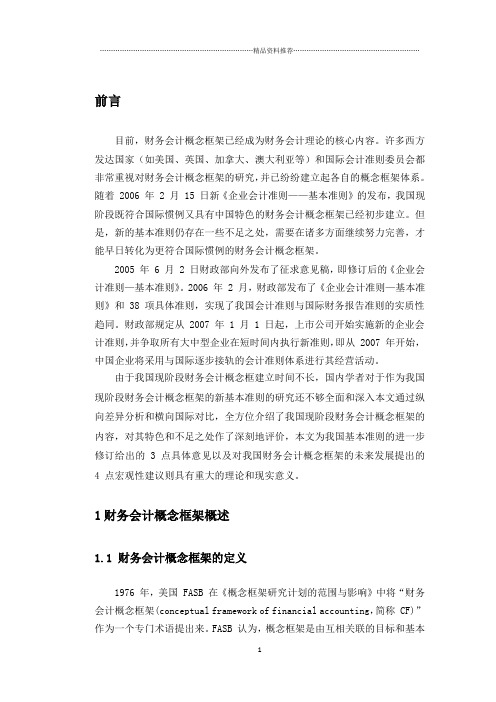
前言目前,财务会计概念框架已经成为财务会计理论的核心内容。
许多西方发达国家(如美国、英国、加拿大、澳大利亚等)和国际会计准则委员会都非常重视对财务会计概念框架的研究,并已纷纷建立起各自的概念框架体系。
随着 2006 年 2 月 15 日新《企业会计准则——基本准则》的发布,我国现阶段既符合国际惯例又具有中国特色的财务会计概念框架已经初步建立。
但是,新的基本准则仍存在一些不足之处,需要在诸多方面继续努力完善,才能早日转化为更符合国际惯例的财务会计概念框架。
2005 年 6 月 2 日财政部向外发布了征求意见稿,即修订后的《企业会计准则—基本准则》。
2006 年 2 月,财政部发布了《企业会计准则—基本准则》和 38 项具体准则,实现了我国会计准则与国际财务报告准则的实质性趋同。
财政部规定从 2007 年 1 月 1 日起,上市公司开始实施新的企业会计准则,并争取所有大中型企业在短时间内执行新准则,即从 2007 年开始,中国企业将采用与国际逐步接轨的会计准则体系进行其经营活动。
由于我国现阶段财务会计概念框建立时间不长,国内学者对于作为我国现阶段财务会计概念框架的新基本准则的研究还不够全面和深入本文通过纵向差异分析和横向国际对比,全方位介绍了我国现阶段财务会计概念框架的内容,对其特色和不足之处作了深刻地评价,本文为我国基本准则的进一步修订给出的 3 点具体意见以及对我国财务会计概念框架的未来发展提出的4 点宏观性建议则具有重大的理论和现实意义。
1财务会计概念框架概述1.1 财务会计概念框架的定义1976 年,美国 FASB 在《概念框架研究计划的范围与影响》中将“财务会计概念框架(conceptual framework of financial accounting,简称 CF)”作为一个专门术语提出来。
FASB 认为,概念框架是由互相关联的目标和基本概念所组成的逻辑一致的体系,这些目标和基本概念可以用来引导首尾一贯的准则,并对财务会计的性质、作用和局限性做出规定。
2018财务会计概念框架

2018财务会计概念框架2018年财务会计概念框架是由国际会计准则理事会(International Accounting Standards Board,IASB)发布的一项指导性文件,旨在规范和统一全球范围内财务会计的准则和原则。
该概念框架提供了一个共同的理论基础,以便制定和解释财务报表准则。
以下是关于2018财务会计概念框架的一些重要内容和要点:1. 目的和目标,概念框架的主要目的是为制定和解释财务报表准则提供指导。
其目标是提供有关财务报告的信息质量、可比性和可理解性的准则。
2. 财务报告的特征,财务报告应具备相关性、可靠性、可比性和可理解性。
相关性指信息对用户的决策有用;可靠性指信息应当真实、完整和中立;可比性指信息应当具有可比性,以便用户进行比较;可理解性指信息应当以清晰、简明的方式呈现。
3. 资产、负债和所有者权益,资产是企业拥有的具有经济利益的资源;负债是企业对外部实体的现时义务;所有者权益是企业剩余资产的归属。
4. 收入和费用,收入是企业在经营活动中产生的经济利益的流入;费用是企业在经营活动中产生的经济利益的流出。
5. 财务报表要素,财务报表要素包括资产、负债、所有者权益、收入和费用。
这些要素是构成财务报表的基本组成部分。
6. 会计确认和计量,会计确认是指将经济事项纳入财务报表的过程;会计计量是指确定和表达经济事项的金额。
7. 财务报表的编制和披露,财务报表应当按照财务报告准则进行编制,并应当披露与企业财务状况和经营成果相关的重要信息。
总的来说,2018财务会计概念框架为制定和解释财务报表准则提供了指导,确保财务报表的信息质量和可理解性。
它涵盖了财务报告的特征、资产、负债、所有者权益、收入和费用等要素,以及会计确认、计量和财务报表的编制和披露等方面的内容。
这些准则和原则对于企业编制财务报表和用户理解财务信息都具有重要意义。
国际财务报告准则概念框架的主要内容
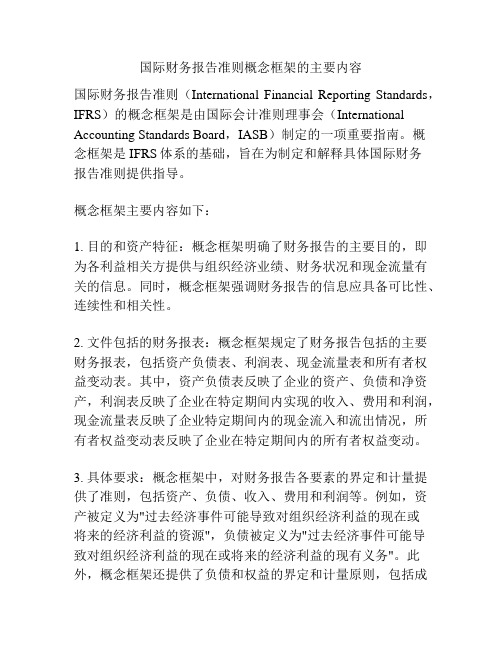
国际财务报告准则概念框架的主要内容国际财务报告准则(International Financial Reporting Standards,IFRS)的概念框架是由国际会计准则理事会(International Accounting Standards Board,IASB)制定的一项重要指南。
概念框架是IFRS体系的基础,旨在为制定和解释具体国际财务报告准则提供指导。
概念框架主要内容如下:1. 目的和资产特征:概念框架明确了财务报告的主要目的,即为各利益相关方提供与组织经济业绩、财务状况和现金流量有关的信息。
同时,概念框架强调财务报告的信息应具备可比性、连续性和相关性。
2. 文件包括的财务报表:概念框架规定了财务报告包括的主要财务报表,包括资产负债表、利润表、现金流量表和所有者权益变动表。
其中,资产负债表反映了企业的资产、负债和净资产,利润表反映了企业在特定期间内实现的收入、费用和利润,现金流量表反映了企业特定期间内的现金流入和流出情况,所有者权益变动表反映了企业在特定期间内的所有者权益变动。
3. 具体要求:概念框架中,对财务报告各要素的界定和计量提供了准则,包括资产、负债、收入、费用和利润等。
例如,资产被定义为"过去经济事件可能导致对组织经济利益的现在或将来的经济利益的资源",负债被定义为"过去经济事件可能导致对组织经济利益的现在或将来的经济利益的现有义务"。
此外,概念框架还提供了负债和权益的界定和计量原则,包括成本计量和公允价值计量。
4. 其他重要概念:概念框架还涵盖了一些其他重要概念,如会计政策、会计估计、会计判断和会计报告的时间跨度等。
它还讨论了企业连续经营假设、资本维持概念以及财务报表中重要的披露要求。
5. 决策者透明度:概念框架强调财务报告应具备决策者透明度,以提供对决策者有价值的信息,帮助决策者评估企业的经济业绩、风险状况和未来展望。
总体而言,国际财务报告准则概念框架为财务报告提供了基本的指导原则和定义,帮助企业制定准确、可比、透明的财务报告。
- 1、下载文档前请自行甄别文档内容的完整性,平台不提供额外的编辑、内容补充、找答案等附加服务。
- 2、"仅部分预览"的文档,不可在线预览部分如存在完整性等问题,可反馈申请退款(可完整预览的文档不适用该条件!)。
- 3、如文档侵犯您的权益,请联系客服反馈,我们会尽快为您处理(人工客服工作时间:9:00-18:30)。
谢
观赏
谢
那财务会计概念框架有哪些内容呢
财务会计框架主要内容
会计目标
财务会计概念框架
第一层次
会计基本假设
会计对象
会计要素
第二层次
信息质量特征
第三层次
会计要素确认、计量与报
告
FASB与IASC之比较
美国财务会计概念框架主要内容(FASB)
目标
质量特征
要素
确认与计量概 念
约束条件
财务报表
IASC概念框架
前言
财务会计概念框架
FASB与IASC之比较
财务会计概念框架定义及 其主要内容
什么是财务会计概念框架
简单的说,概念框架就是用来阐释整个会计报表的 主要导向的基础性说明。 财务会计概念框架是由一 系列说明财务会计并为财务会计所应用的基本概念 所组成的理论体系,它可用来评估现有的会计准则、 指导并发展未来的会计准则和解决现有的会计准则 未 曾 涉 及 到 的 新 会 计 问 题 。
历史成本
IASC
历史成本
现行成本或重置成本; 现行价值
可变现净值
现行成本
可 变 现 价 值 ( 或 结 算 价 值)
现值
为什么会有 这么多差异 呢?
现值
差异原因
FASB 主要研究对象是美国会计界的发展,二 IASC 需要 兼顾世界各国会计框架体系,体现了其国际协调作用 IASC又因为其所特有国际协调角色,兼收并蓄,干预进 行创新,引入新的内容 FASB 是世界上最早发布的概念框架公告,体系全面, 内在逻辑严谨,而 IASC 远没有 FASB 历史悠久,体系也 相对稍有不成熟 财务会计框架牵扯这各方利益, FASB 显然是符合美国 各方利益集团的,而IASC也要符合其中所牵扯的各方利 益
引言
财务报表目标
基础假设
财务报表的 质量特征
财务报表的 要求
财务报表的 确认
财务报表的 计量
资本和资本 保全概念
会计目标比较
FASB
提供:
IASC
提供:
1.有助于制定决策的信息
2.有助于预测现金流量的 信息
1决策有用的财务信息
2.共同需要而非全部需要 3.反应受托责任
3.关于经济资源、对经济 资源的要求权,以及资源 的要求权变化的信息
4.报表、附注与附表
会计基本假设
FASB
经济主体
IASC
权责发生制
持续经营
分期 货币单位
持续经营
使用者及其信息需求 会计模式与资本保全
信息质量特征要求比较
FASB
IASC
可理解性 主要:
可理解性
相关性:预测价值
反馈价值 及时性 如实反应 中立性 一致性
相关性
可靠性 可比性
可靠性:可验证性
相关/可行性的制约因素
真实和公允观点 / 公允表 述
次要:可比性
会计要素
FASB
IASC
资产 负债
资产
Байду номын сангаас
权益
所有者投资 所有者分派 收入 费用 利得 损失 全面收益
负债
权益 业绩
收益
费用
会计要素确认
FASB
IASC
可定义性、 可计量性、 相关性和可靠性;盈利确 认的补充指南:收入已赚 得、已实现或可实现;费 用指报告期内经济利益的 消耗(耗用)或发生未来 经济利益的损失
与 该 项 目 有 关 经 济 利 益 将很可能流入或流出企业; 对该项目的成本或价值能 够可靠地加以计量
会计计量
FASB
